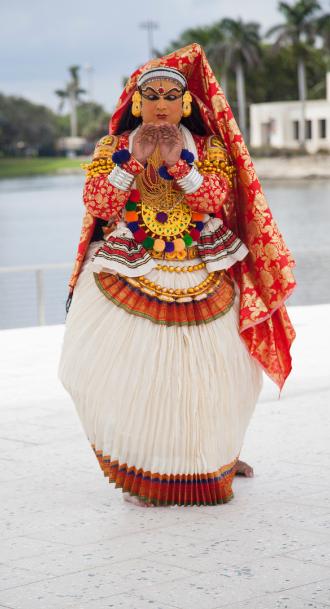Kathakali is a wordless narrative dance set to rhythmic music. Performed exclusively by men, it is known for its elaborate costumes and makeup, detailed hand gestures, and striking facial expressions. It originated in what is now the Kerala region in southern India in the 1700s.
 |
Performances focus on Hindu mythologies of gods, goddesses and sacred figures, bringing the characters to life on the stage.
Arthi Devarajan, visiting assistant professor of religious studies, was quick to sign on when she learned about project. “Usually when artists of this caliber visit the U.S., their goal is to stage full-fledged, ticketed concerts and performance events for the purpose of entertainment,” she said. “But here, we have an opportunity to hear these artists speak about their work, explain the nuances of the tradition, and answer questions that further the research interests and goals of UM community members who work across disciplines.”The UM College of Arts & Sciences Department of Religious studies coordinated the visit of three Kathakali masters, who hail from Kalamandalam University for Art and Culture in Kerala – a highly prestigious performing arts institution. Professor V. Kaladharan, a scholar and researcher on Indian classical arts, narrated the dance. Renowned Kathakali actor Shanmughadas performed, and K. Sukumaran was the official costumer and makeup artist. The three artists are touring U.S. universities this fall.
The Departments of History and Theatre Arts co-sponsored the visit, along with the Center for the Humanities, the Program in Women’s and Gender Studies, the Offices of the Dean of the College of Arts & Sciences and the Senior Vice Provost, the Study Abroad Office, the Hindu Students Council and the Indian Students Association.
In addition to the performance, the artists taught a master class to dance students in the Department of Theatre Arts during their time on campus.
Devarajan’s research focuses on west and south Asian religions, and her first book examines the traditional classical dance forms of India as sites of religious and ethical pedagogy.
“For many communities in South Asia – and other parts of the world – religion is about lived experience, the senses and embodied experiences of living in the world and the way that stories are shared across time. Within the worlds of Hinduism and Indian religions, Kathakali plays an important role,” she said, adding, “It is a living tradition that engages the senses, both of the performers and the audience alike.
During a pre-performance lecture on Kathakali technique, Professor Kaladharan described – and Shanmughadas demonstrated – the 24 hand gestures and nine facial expressions used to tell stories in Kathakali. “Each part of the body and face is trained separately. Then all the parts are integrated,” Kaladharan said.
Kathakali actors begin training at about age 12. For most, it is immediately evident if they are more adept at portraying male or female characters. Shanmughadas, however, is the rare performer who can do both. It takes him three to four hours to apply his intricate makeup and costumes.
“Kathakali is the interplay of the celestial and the terrestrial,” Kaladharan said.
Devarajan said, “The intricate constructions of facial expression, hand gestures, and movement in Kathakali have been honed over centuries to generate an experience in audiences known in Sanskrit as ‘rasa’ – literally, an ‘essence.’ This emotion, and the value that people then relate to it – good, bad, right or wrong – inevitably gives human beings data that informs religious value.”
She added, “Religion, for many, is more than reading an ancient text or reflecting on belief. Religion draws from embodied experience as well.”
October 27, 2014

